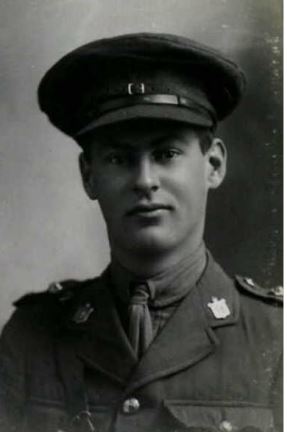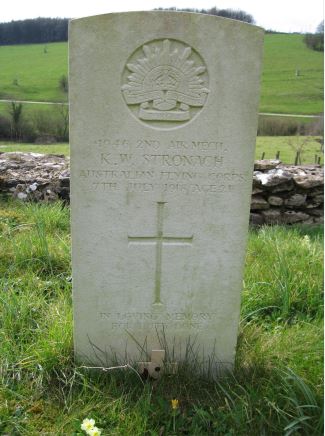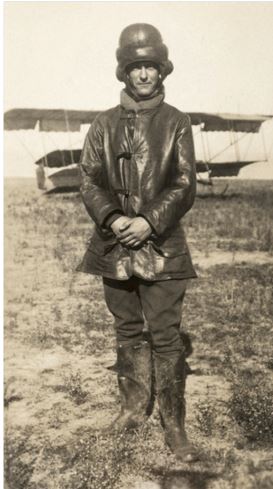No 7 Training Squadron, Australian Flying Corps

Keith William Stronach was born on 2 February 1896 at Melbourne, Victoria, Australia, the son of Samuel W and Margarette Stronach, who lived at 1048 Hay Street West, Perth, Western Australia.
He had studied to be a civil engineer, gaining a BSc at Adelaide, South Australia. Having been born in Victoria, lived in Western Australia and studied in South Australia, it was at Brisbane, Queensland, where he attested for military service on 21 February 1917, aged 21.
His attestation papers reveal that he had had some previous military service. For two years he had been a Senior Army Cadet (as a Lieutenant), one year as a Lieutenant in the Citizen Forces 86th Infantry and for the four month period 8 August to 22 December 1916 he had been a member of the Australian Flying Corps (AFC), where he gained some flying experience with Bristol, Grahame White and BE2 types.
Given the above involvement it is not quite clear why he had to attest for military service at Brisbane, on 20 February 1917. From his service papers it would appear that he applied to be a motor cyclist in the AFC. However, it is not clear if this happened. He was posted to 11th Depot, as Private, from 22 to 23 February 1917 and transferred to the Engineers, as a Sapper, on 24 February. However, his wish to join the AFC appears to have been realised on 7 March 1917, with a posting to the AFC Camp at Laverton, a suburb of Melbourne and a temporary promotion to the rank of Sergeant.
On 4 August 1917 he sailed from Melbourne for Europe, on board the HMAT Themistocles and arrived at Glasgow on 2 October 1917. From here he went to the AFC Depot, Halton Camp, near Wendover, Buckinghamshire and spent the period 19 November to 26 December 1917 at the School of Gunnery, Hythe in Kent. In early February 1918 he was afflicted with tonsillitis and spent a few days in the 2nd Australian Auxiliary Hospital, St Marylebone School, Southall.
On 1 March he was posted to No 2 School of Military Aero at Oxford, followed by a spell at the AFC Depot, Uxbridge. On 6 June he arrived at 7th Training Squadron, AFC, Leighterton, Gloucestershire to start his training as a pilot. He carried the rank of Air Mechanic Second Class but appears to have been known as a Cadet.
His initial training was on the BE2, with 10 hours dual and 10 hours and 35 minutes of solo flying logged. He then moved on to the RE8 (known by the nick name ‘Harry Tait’). Up to 7 July he had completed one hour and 45 minutes duel tuition and was about to embark on his first solo flight in this type.
The weather was good on the morning of 7 July and Captain H N Wrigley, commander of C Flight, No 7 Training Squadron had taken the RE8 registration D/1513 up on dual instruction on two occasions, once accompanying Cadet Stronach. The aeroplane had performed perfectly with no hint of mechanical defect. Wrigley had every confidence in Stronach’s ability and considered him his most promising pupil. What happened next was revealed at a subsequent Court of Enquiry and Inquest.
At 7.55am Cadet Stronach prepared for his solo in RE8 D/1513. Wrigley saw it was correctly trimmed and the engine test went well. He watched Stronach take off and fly west from the aerodrome. Upon reaching a height of about 1,000 feet Stronach turned the machine left and flew east towards the aerodrome for about two minutes. Suddenly the engine failed with a loud bang and stopped. The machine went into a normal glide and disappeared behind a clump of trees near to Boxwell House, after which a slight crash was heard. Wrigley immediately set off for the scene of the crash and upon arrival discovered that they aeroplane had stalled as Stronach had tried to pull up the nose to avoid hitting a hedge and had dived into the ground. The pilot had made certain that switches for the engine and petrol supply were off, so there was no fire. The crash had been witnessed by two members of 648th Agricultural Labour Corps, and Private F Scott told the Court of Enquiry that having seen the aeroplane crash he and his colleague ran to the crash site and discovered the pilot strapped in his seat, with his head hanging over the right side of the cockpit. His neck appeared to be broken. The two soldiers unfastened him and lifted him onto a wing before an ambulance arrived. Cadet Stronach had died on impact of a broken neck.
Squadron Commander, Major W A Anderson reported that Cadet Stronach was one of the most promising pupils in the Squadron and had done very well in practising forced landings the day before the crash. This time he apparently dropped just short of his field and stalled in trying to get over the hedge. He was on duty and not to blame.
Whether or not the reason for the engine failure was ever discovered is not known, however, the engine was extensively damaged and aircraft of those times were notoriously unreliable and flying, even outside of combat conditions, was extremely dangerous. It was declared that Cadet Stronach’s death was accidental; the result of mechanical failure and no blame was attached to him. He was aged just 21.
Keith Stronach was buried on 9 July 1918. A funeral procession left Leighterton aerodrome at 2pm and proceeded to Lasborough (St Mary) Church where there was a short service as part of a military funeral. He was buried in the churchyard, where a standard CWGC headstone marks his grave. This churchyard is located in a remote spot, quite some way up a track which leads from the A46 which links Bath with Stroud. Stronach is the only Australian airman buried there, whilst there are 23 buried in the cemetery at Leighterton. Why he is buried at Lasborough is puzzling.


Researched by Graham Adams 8 March 2013
